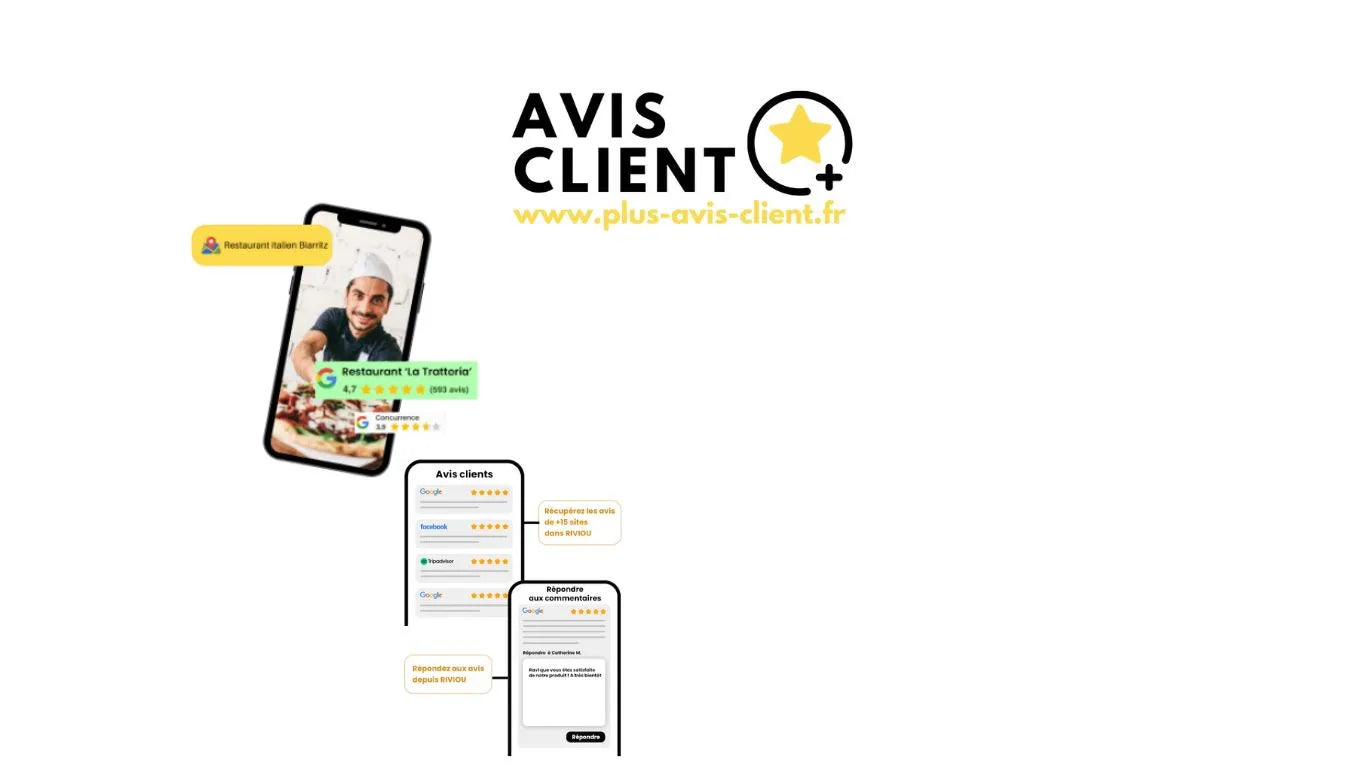
Improve your customer relationship through constructive feedback
The importance of feedback in customer relations
Customer feedback plays a vital role in improving our products and services. By analyzing this feedback , we gain a better understanding of consumer needs and expectations while identifying areas for improvement. Constructive feedback is a valuable opportunity to turn a weakness into an opportunity, thereby strengthening customer relationships .

Role of customer feedback
Customer feedback is essential for highlighting a company's strengths and identifying areas for improvement. Each piece of feedback, whether positive or critical, provides a unique perspective for tailoring our offerings to meet consumer expectations.
By centralizing and organizing this feedback , we are better equipped to leverage it and integrate it into our development strategies. This process is not only essential for building audience loyalty, but also for proving that their opinions are taken into account, thus strengthening their trust.
Implementing a survey system simplifies the collection of feedback. This approach gives us a global view of expectations and helps improve our e-reputation and customer relations .
For example, a company that has received complaints about its delivery times could rework its logistics processes and see a 20% reduction in these times.
Constructive feedback and continuous improvement
Constructive feedback , even when it points out flaws, helps identify areas for improvement. By using this information to improve a product or service, an unsatisfying customer experience can be transformed into a moment of loyalty.
Negative feedback should not be seen as a threat, but as an opportunity. Addressing this feedback proactively demonstrates a commitment to continuous improvement and strengthens customer relationships .
By valuing customer feedback and involving them in improving our offerings, we cultivate customer loyalty and a sense of belonging while recognizing the value of their contributions.
Tools for better returns management
To fully leverage customer feedback , it is crucial to centralize and analyze it effectively. Using appropriate tools, such as a CRM , can simplify this process while accurately meeting expressed expectations.
Regular surveys provide constructive feedback that's essential for understanding customer requirements. Incorporating open-ended questions into these processes allows you to gather detailed information about their specific preferences and needs.
Finally, maintaining direct communication with our customers demonstrates that we take their opinions into consideration. This active listening strengthens customer relationships and helps project a positive and strong brand image.
Optimizing returns for a solid e-reputation
Customer feedback plays a crucial role in strengthening a company's online reputation . Intelligent and strategic management of this feedback helps build a positive image that inspires both trust and loyalty.
Responses to Negative Reviews
Responding professionally and transparently to negative reviews is essential for building consumer trust. It demonstrates that the company is attentive and willing to resolve issues, which is crucial for developing a strong online reputation .
By turning negative feedback into an opportunity for improvement, a company can not only correct its mistakes, but also build customer loyalty through the quality and relevance of its responses.
Providing clear and transparent responses while explaining the actions taken following reviews reflects a strong commitment to customer satisfaction . This has a direct and positive impact on brand image.
Using positive feedback
Positive reviews play a major role in creating brand ambassadors. These satisfied customers share their experiences, strengthening the company's credibility and attracting new prospects.
Highlighting authentic customer testimonials helps build an image of authenticity and foster loyalty. These personal stories are a powerful way to demonstrate the quality of the products or services offered.
In a marketing strategy, using concrete examples and successes based on feedback is a highly effective tool for attracting a new audience. Companies that value and integrate active customer feedback clearly stand out in their market.
Strategies for a sustainable e-reputation
Adopting transparent public communication, especially when responding to sensitive feedback, reinforces the strength and reliability of the brand. It demonstrates real openness and a high level of professionalism.
Responding quickly to every feedback demonstrates the importance the company places on its customers and their central role in its growth strategy.
By incorporating constructive feedback as a driver for improvement, a company demonstrates its ability to evolve and adapt. This not only inspires trust , but also public esteem, thus contributing to a lasting e-reputation .
Effective communication to strengthen relationship management
To establish effective customer relationship management , it is essential to prioritize transparent and proactive communication. Transforming customer feedback into concrete improvements helps enrich the customer experience .
Tools for smooth communication
Effective communication relies on the adoption of processes geared towards active listening . These methods promote seamless and uninterrupted omnichannel relationship management .
- Team available : Train specialized teams to better handle customer returns.
- Technological tools : Use tools like CRM to centralize and maximize the use of data.
- Regular Interactivity : Plan regular interactive sessions with customers to strengthen the bond and loyalty.
Sharing successes based on customer feedback with the community shows that their opinions are heard and valued. This humanizes the brand and strengthens loyalty.
For example, companies like Starbucks and Spotify are exemplary examples of how to integrate feedback into a customer-centric and data-driven approach.
Optimizing channels for omnichannel
Implementing an omnichannel strategy ensures that every interaction is seamless, regardless of the platform used.
For optimal consistency, it's crucial to collect feedback centrally, facilitating accurate analysis. A well-thought-out omnichannel strategy transforms customer interactions into a continuous and beneficial conversation.
In this context, continuous learning plays a key role. Training teams adequately improves every interaction, transforming each contact into an opportunity for enrichment and improvement.
Role of surveys and personalization
Regular surveys allow us to assess and measure customer satisfaction, giving us the opportunity to adapt our strategies in real time for greater efficiency.
By integrating the feedback and trends identified, we adjust our marketing messages to highlight the most relevant aspects of our offer.
Personalized feedback sends a critical message: every customer matters. This personalization fosters loyalty and builds brand trust.
Personalization and loyalty in customer relations
In a highly competitive environment, customer loyalty relies on a continuous effort to meet the specific expectations of each consumer. Personalizing customer relationships plays a key role in creating a strong and meaningful connection.
Importance of Personalization
Businesses that take the time to listen and respond to customer feedback often see greater loyalty . Delivering a personalized customer experience , whether through tailored offers or recommendations based on purchase history, demonstrates a real investment in individual consumer needs.
Taking customer feedback into account and incorporating customer suggestions demonstrates responsiveness to their expectations. This approach empowers customers, strengthening their commitment to the brand.
For example, a company like Spotify perfectly illustrates this concept by creating playlists tailored to the tastes of its users, thus demonstrating the effectiveness of personalization in loyalty.
Loyalty strategies
A successful customer loyalty strategy requires paying attention to expectations and responding effectively to suggestions. This involves continually adapting offers to keep pace with changing consumer needs.
Customer reviews are a valuable tool for identifying sometimes unspoken, but very real, needs. Offering specific products or services based on this feedback strengthens the relevance and effectiveness of customer relationships.
Tangibly demonstrating that improvements were made based on their suggestions helps strengthen the relationship. Customers truly appreciate seeing that their opinion has positively influenced their own experience and that of future users.
In short, a thoughtful and well-executed personalization strategy can positively influence future purchasing decisions, creating a prosperous and beneficial relationship for both the brand and its customers.
Using feedback to improve products and services
Customer feedback has immense potential for the continuous improvement of our products and services . It is a key tool for refining our offering and ensuring even greater customer satisfaction .
Optimize through feedback analysis
The first step towards improvement is a thorough analysis of customer feedback . This data directly guides our innovations based on consumer expectations and criticism.
- Identify weaknesses : Feedback highlights areas for improvement.
- Strengthen strengths : Positive aspects are validated and optimized.
- Meeting expectations : They also reveal the implicit needs that remain to be satisfied.
By providing concrete solutions to criticism, we demonstrate our commitment to delivering optimal quality. This approach builds trust with our customers, who appreciate our active listening skills and ability to respond quickly.
By valuing feedback , our brand constantly adjusts its strategies, thus demonstrating a strong desire for adaptation and continuous innovation.
Create a continuous improvement loop
Building a dynamic of improvement based on a constant flow of feedback effectively fuels our long-term strategies. These iterative, feedback-driven adjustments reflect our agile approach to market changes.
Data from feedback analysis not only provides concrete solutions but also a deep understanding of consumer trends and expectations.
Combining product design with customer suggestions – much like a brand would do by adapting its models based on feedback – illustrates how we translate feedback into measurable actions.
Ultimately, leveraging customer feedback intelligently redefines our optimization processes and ensures both high and consistent satisfaction.
Encourage innovation
Customer feedback isn't just about pointing out flaws or confirming successes. It's a valuable source of inspiration, stimulating thought and inspiring our teams to innovate.
Careful listening combined with accurate interpretation of expectations pushes us to anticipate and exceed market needs.
Adopting a culture of flexibility and adaptation not only ensures you stay constantly moving, but also grows in the face of challenges and opportunities revealed by the feedback you gather.
Through continuous improvement guided by feedback , we position ourselves as an innovative leader, always concerned about the well-being and satisfaction of our customers.
Improve customer experience to effectively build loyalty
Continuous improvement of the customer experience relies on constructive feedback from our users. When used intelligently , this feedback positively influences long-term loyalty and satisfaction .
Continuous improvement strategies
Implementing a proactive and integrated approach to collecting feedback significantly improves all aspects of the services offered.
- Targeted collection : Deploy tools to precisely identify needs and expectations.
- Boosted responsiveness : Provide rapid and appropriate responses to each feedback received.
- Concrete avenues : Transform feedback into innovative and relevant proposals.
- Evaluation metrics : Use tools such as CSAT or NPS to measure the impacts of actions taken.
By adopting these approaches, the company demonstrates exemplary diligence, while making continuous improvement part of its DNA.
Ignoring customer feedback risks creating a disconnect from real expectations. However, adapting quickly to this feedback helps maintain ongoing relevance and remain competitive.
Role of CRM tools
To establish a richer relationship with customers, it is essential to use a powerful CRM , capable of centralizing and analyzing the collected data.
A well-structured CRM consolidates all customer interactions, making follow-up both personalized and efficient. Each user feedback then becomes a valuable opportunity to enhance their experience .
By leveraging insights from data, the company adapts its offerings to needs, whether clearly expressed or implicit, thereby strengthening its service.
Public interaction and credibility
Responding quickly and proactively to customer feedback not only strengthens a brand's credibility, but also builds trust. Each personalized response is a tangible demonstration of commitment to customers.
Additionally, public engagement from satisfied customers helps to spread a positive and credible image, while amplifying brand awareness.
Conducting regular follow-ups ensures that no request goes unanswered, and guarantees that each consumer is truly heard and served according to their specific expectations.

